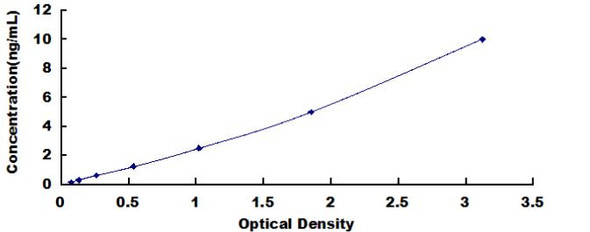Description
Rat Myc proto-oncogene protein (Myc) ELISA Kit
The Rat MYC Proto-Oncogene Protein (MYC) ELISA Kit is specifically designed for the accurate measurement of MYC levels in rat samples including serum, plasma, and cell culture supernatants. This kit offers high sensitivity and specificity, ensuring precise and reproducible results for a variety of research applications.MYC is a key regulator of cell growth and proliferation, playing a critical role in various biological processes including tumorigenesis and cancer progression.
By measuring MYC levels, researchers can gain valuable insights into the mechanisms underlying cancer development and potentially identify new therapeutic targets.Overall, the Rat MYC Proto-Oncogene Protein (MYC) ELISA Kit is a valuable tool for studying MYC biology and its role in disease pathology, making it an essential component of any research laboratory focused on cancer research and drug discovery.
| Product Name: | Rat Myc proto-oncogene protein (Myc) ELISA Kit |
| SKU: | RTEB0845 |
| Size: | 96T |
| Target: | Rat Myc proto-oncogene protein (Myc) |
| Synonyms: | Proto-oncogene c-Myc, Transcription factor p64 |
| Assay Type: | Sandwich |
| Detection Method: | ELISA |
| Reactivity: | Rat |
| Detection Range: | 31.2-2000pg/mL |
| Sensitivity: | 14.8pg/mL |
| Intra CV: | 4.2% | ||||||||||||||||||||
| Inter CV: | 5.6% | ||||||||||||||||||||
| Linearity: |
| ||||||||||||||||||||
| Recovery: |
| ||||||||||||||||||||
| Function: | Transcription factor that binds DNA in a non-specific manner, yet also specifically recognizes the core sequence 5'-CAC[GA]TG-3'. Activates the transcription of growth-related genes. |
| Uniprot: | P09416 |
| Sample Type: | Serum, plasma, tissue homogenates, cell culture supernates and other biological fluids |
| Specificity: | Natural and recombinant rat Myc proto-oncogene protein |
| Sub Unit: | Efficient DNA binding requires dimerization with another bHLH protein. Binds DNA as a heterodimer with MAX. Interacts with TAF1C and SPAG9. Interacts with PARP10. Interacts with KDM5A and KDM5B. Interacts (when phosphorylated at Thr-58 and Ser-62) with FBXW7. Interacts with PIM2. Interacts with NO66. The heterodimer MYC:MAX interacts with ABI1; the interaction may enhance MYC:MAX transcriptional activity. Interacts with TRIM6. |
| Research Area: | Development Biology |
| Subcellular Location: | Nucleus Nucleoplasm Nucleus Nucleolus |
| Storage: | Please see kit components below for exact storage details |
| Note: | For research use only |
| UniProt Protein Function: | Myc: a proto-oncogenic transcription factor that plays a role in cell proliferation, apoptosis and in the development of human tumors. Seems to activate the transcription of growth-related genes. |
| UniProt Protein Details: | Protein type:Oncoprotein; Transcription factor; DNA-binding; Nucleolus Cellular Component: axon; cytoplasm; mitochondrion; nuclear body; nucleolus; nucleoplasm; nucleus; perinuclear region of cytoplasm; protein complex; spindle Molecular Function:DNA binding; double-stranded DNA binding; protein binding; protein complex binding; protein dimerization activity; protein heterodimerization activity; sequence-specific DNA binding; transcription factor activity; transcription factor binding; ubiquitin protein ligase binding Biological Process: amino acid transport; B cell apoptosis; caspase activation; cell cycle arrest; cell proliferation; cellular iron ion homeostasis; cellular response to insulin stimulus; chromatin remodeling; chromosome organization and biogenesis; detection of mechanical stimulus involved in sensory perception of sound; DNA damage response, signal transduction resulting in induction of apoptosis; flavonoid metabolic process; G0 to G1 transition; glucose metabolic process; hypothalamus development; in utero embryonic development; inner mitochondrial membrane organization and biogenesis; lactic acid secretion; MAPKKK cascade; middle ear morphogenesis; negative regulation of cell division; negative regulation of fibroblast proliferation; negative regulation of glucose import; negative regulation of monocyte differentiation; negative regulation of protein binding; negative regulation of transcription from RNA polymerase II promoter; ovarian follicle development; ovulation; pathogenesis; pigmentation; positive regulation of B cell apoptosis; positive regulation of caspase activity; positive regulation of catalytic activity; positive regulation of cell cycle; positive regulation of cell proliferation; positive regulation of DNA binding; positive regulation of epithelial cell proliferation; positive regulation of fibroblast proliferation; positive regulation of glycolysis; positive regulation of mesenchymal cell proliferation; positive regulation of smooth muscle cell migration; positive regulation of smooth muscle cell proliferation; positive regulation of transcription from RNA polymerase II promoter; positive regulation of transcription, DNA-dependent; protein processing; pyruvate transport; re-entry into mitotic cell cycle; regulation of apoptosis; regulation of gene expression; regulation of mitotic cell cycle; regulation of oxidative phosphorylation; regulation of telomere maintenance; regulation of transcription, DNA-dependent; response to alkaloid; response to DNA damage stimulus; response to drug; response to estradiol stimulus; response to ethanol; response to gamma radiation; response to radiation; response to wounding; skeletal morphogenesis; transcription from RNA polymerase II promoter; transcription initiation; transcription, DNA-dependent; transformation of host cell by virus; ureteric bud branching; Wnt receptor signaling pathway; Wnt receptor signaling pathway through beta-catenin |
| NCBI Summary: | The protein encoded by this gene is a multifunctional, nuclear phosphoprotein that plays a role in cell cycle progression, apoptosis and cellular transformation. It functions as a transcription factor that regulates transcription of specific target genes. Mutations, overexpression, rearrangement and translocation of this gene have been associated with a variety of hematopoietic tumors, leukemias and lymphomas, including Burkitt lymphoma, in human. There is evidence to show that alternative translation initiations from an upstream, in-frame non-AUG (CUG) and a downstream AUG start site result in the production of two isoforms with distinct N-termini, in human and mouse. Rat mRNA also has a similarly placed CUG upstream of the AUG start site, suggesting that it may also produce two Myc proteins. [provided by RefSeq, Jul 2008] |
| UniProt Code: | P09416 |
| NCBI GenInfo Identifier: | 71834866 |
| NCBI Gene ID: | 24577 |
| NCBI Accession: | NP_036735.2 |
| UniProt Secondary Accession: | P09416,Q6B500, |
| UniProt Related Accession: | P09416 |
| Molecular Weight: | 48,898 Da |
| NCBI Full Name: | myc proto-oncogene protein |
| NCBI Synonym Full Names: | myelocytomatosis oncogene |
| NCBI Official Symbol: | Myc |
| NCBI Official Synonym Symbols: | mMyc; c-myc; RNCMYC |
| NCBI Protein Information: | myc proto-oncogene protein |
| UniProt Protein Name: | Myc proto-oncogene protein |
| UniProt Synonym Protein Names: | Proto-oncogene c-Myc; Transcription factor p64 |
| Protein Family: | Myc protein |
| UniProt Gene Name: | Myc |
| UniProt Entry Name: | MYC_RAT |
| Component | Quantity (96 Assays) | Storage |
| ELISA Microplate (Dismountable) | 8×12 strips | -20°C |
| Lyophilized Standard | 2 | -20°C |
| Sample Diluent | 20ml | -20°C |
| Assay Diluent A | 10mL | -20°C |
| Assay Diluent B | 10mL | -20°C |
| Detection Reagent A | 120µL | -20°C |
| Detection Reagent B | 120µL | -20°C |
| Wash Buffer | 30mL | 4°C |
| Substrate | 10mL | 4°C |
| Stop Solution | 10mL | 4°C |
| Plate Sealer | 5 | - |
Other materials and equipment required:
- Microplate reader with 450 nm wavelength filter
- Multichannel Pipette, Pipette, microcentrifuge tubes and disposable pipette tips
- Incubator
- Deionized or distilled water
- Absorbent paper
- Buffer resevoir
*Note: The below protocol is a sample protocol. Protocols are specific to each batch/lot. For the correct instructions please follow the protocol included in your kit.
Allow all reagents to reach room temperature (Please do not dissolve the reagents at 37°C directly). All the reagents should be mixed thoroughly by gently swirling before pipetting. Avoid foaming. Keep appropriate numbers of strips for 1 experiment and remove extra strips from microtiter plate. Removed strips should be resealed and stored at -20°C until the kits expiry date. Prepare all reagents, working standards and samples as directed in the previous sections. Please predict the concentration before assaying. If values for these are not within the range of the standard curve, users must determine the optimal sample dilutions for their experiments. We recommend running all samples in duplicate.
| Step | |
| 1. | Add Sample: Add 100µL of Standard, Blank, or Sample per well. The blank well is added with Sample diluent. Solutions are added to the bottom of micro ELISA plate well, avoid inside wall touching and foaming as possible. Mix it gently. Cover the plate with sealer we provided. Incubate for 120 minutes at 37°C. |
| 2. | Remove the liquid from each well, don't wash. Add 100µL of Detection Reagent A working solution to each well. Cover with the Plate sealer. Gently tap the plate to ensure thorough mixing. Incubate for 1 hour at 37°C. Note: if Detection Reagent A appears cloudy warm to room temperature until solution is uniform. |
| 3. | Aspirate each well and wash, repeating the process three times. Wash by filling each well with Wash Buffer (approximately 400µL) (a squirt bottle, multi-channel pipette,manifold dispenser or automated washer are needed). Complete removal of liquid at each step is essential. After the last wash, completely remove remaining Wash Buffer by aspirating or decanting. Invert the plate and pat it against thick clean absorbent paper. |
| 4. | Add 100µL of Detection Reagent B working solution to each well. Cover with the Plate sealer. Incubate for 60 minutes at 37°C. |
| 5. | Repeat the wash process for five times as conducted in step 3. |
| 6. | Add 90µL of Substrate Solution to each well. Cover with a new Plate sealer and incubate for 10-20 minutes at 37°C. Protect the plate from light. The reaction time can be shortened or extended according to the actual color change, but this should not exceed more than 30 minutes. When apparent gradient appears in standard wells, user should terminatethe reaction. |
| 7. | Add 50µL of Stop Solution to each well. If color change does not appear uniform, gently tap the plate to ensure thorough mixing. |
| 8. | Determine the optical density (OD value) of each well at once, using a micro-plate reader set to 450 nm. User should open the micro-plate reader in advance, preheat the instrument, and set the testing parameters. |
| 9. | After experiment, store all reagents according to the specified storage temperature respectively until their expiry. |
When carrying out an ELISA assay it is important to prepare your samples in order to achieve the best possible results. Below we have a list of procedures for the preparation of samples for different sample types.
| Sample Type | Protocol |
| Serum | If using serum separator tubes, allow samples to clot for 30 minutes at room temperature. Centrifuge for 10 minutes at 1,000x g. Collect the serum fraction and assay promptly or aliquot and store the samples at -80°C. Avoid multiple freeze-thaw cycles. If serum separator tubes are not being used, allow samples to clot overnight at 2-8°C. Centrifuge for 10 minutes at 1,000x g. Remove serum and assay promptly or aliquot and store the samples at -80°C. Avoid multiple freeze-thaw cycles. |
| Plasma | Collect plasma using EDTA or heparin as an anticoagulant. Centrifuge samples at 4°C for 15 mins at 1000 × g within 30 mins of collection. Collect the plasma fraction and assay promptly or aliquot and store the samples at -80°C. Avoid multiple freeze-thaw cycles. Note: Over haemolysed samples are not suitable for use with this kit. |
| Urine & Cerebrospinal Fluid | Collect the urine (mid-stream) in a sterile container, centrifuge for 20 mins at 2000-3000 rpm. Remove supernatant and assay immediately. If any precipitation is detected, repeat the centrifugation step. A similar protocol can be used for cerebrospinal fluid. |
| Cell culture supernatant | Collect the cell culture media by pipette, followed by centrifugation at 4°C for 20 mins at 1500 rpm. Collect the clear supernatant and assay immediately. |
| Cell lysates | Solubilize cells in lysis buffer and allow to sit on ice for 30 minutes. Centrifuge tubes at 14,000 x g for 5 minutes to remove insoluble material. Aliquot the supernatant into a new tube and discard the remaining whole cell extract. Quantify total protein concentration using a total protein assay. Assay immediately or aliquot and store at ≤ -20 °C. |
| Tissue homogenates | The preparation of tissue homogenates will vary depending upon tissue type. Rinse tissue with 1X PBS to remove excess blood & homogenize in 20ml of 1X PBS (including protease inhibitors) and store overnight at ≤ -20°C. Two freeze-thaw cycles are required to break the cell membranes. To further disrupt the cell membranes you can sonicate the samples. Centrifuge homogenates for 5 mins at 5000xg. Remove the supernatant and assay immediately or aliquot and store at -20°C or -80°C. |
| Tissue lysates | Rinse tissue with PBS, cut into 1-2 mm pieces, and homogenize with a tissue homogenizer in PBS. Add an equal volume of RIPA buffer containing protease inhibitors and lyse tissues at room temperature for 30 minutes with gentle agitation. Centrifuge to remove debris. Quantify total protein concentration using a total protein assay. Assay immediately or aliquot and store at ≤ -20 °C. |
| Breast Milk | Collect milk samples and centrifuge at 10,000 x g for 60 min at 4°C. Aliquot the supernatant and assay. For long term use, store samples at -80°C. Minimize freeze/thaw cycles. |










